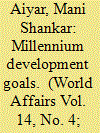|
|
|
Sort Order |
|
|
|
Items / Page
|
|
|
|
|
|
|
| Srl | Item |
| 1 |
ID:
078027


|
|
|
|
|
| Publication |
2007.
|
| Summary/Abstract |
We estimate cigarette price and income elasticities for urban China, 1995. We find an overall cigarette price elasticity of 0.5, which lies between previous estimates. This implies that a 10% increase in price would result in a decline in cigarette consumption of 4.5 billion packs and would raise Y34 billion in additional tax revenue.
|
|
|
|
|
|
|
|
|
|
|
|
|
|
|
|
| 2 |
ID:
163302


|
|
|
|
|
| Summary/Abstract |
Currently, there is no systematic evidence showing that, 15 years or more after entry, all multinational retailers provide lower prices than domestic buying groups. In the short term, some multinational retailers may lower prices to deter local competitors and attract consumers in a ‘loss leader’ strategy. However, domestic competitors can integrate buying groups to share the benefit of economies of scale with multinational retailers, while holding lower profitability requirements and overhead costs than multinational retailers. We compared multinational retailers to domestic buying groups in a jurisdiction that had one of the highest proportions of Walgreens and Walmart stores in the world. Despite their market power, in our representative samples of goods, there is no evidence that the prices of multinational retailers in the sectors of pharmacies, supermarkets and hardware stores are lower than domestic chains.
|
|
|
|
|
|
|
|
|
|
|
|
|
|
|
|
| 3 |
ID:
103934


|
|
|
|
|
| Publication |
2011.
|
| Summary/Abstract |
We developed a methodology to decompose export growth into three margins: extensive margin, price and quantity. We then decomposed data on China's export trade with 140 partners in 2001 and 2007 into the three margins. We arrive at the following conclusions: China's export growth is mainly driven by quantity growth, which accounts for about 70% of overall export growth. This conclusion is robust for different partners, different industries and different techniques. To convert export quantity-driven growth into extensively margin- and quality-driven growth is a major challenge for the Chinese government and China's enterprises in the long term.
|
|
|
|
|
|
|
|
|
|
|
|
|
|
|
|
| 4 |
ID:
178489


|
|
|
|
|
| Summary/Abstract |
This study uses data covering 3,914 farm households, collected from Henan province in China, to investigate the links between the price of agricultural mechanization services and farmers' exit from land operation. The results indicate that the increasing price of agricultural mechanization services leads to farmers leaving land operation, especially when the high sunk costs and the long-term breakeven period of self-owned machinery are considered. This effect is intensified by the rapid rural–urban migration in China. Further analysis reveals that the surge in service prices reduced land renting-in and encouraged non-grain production. Our analysis suggests that the agricultural mechanization service market in China tends to work against the survival of smallholder farmers. However, the price of agricultural mechanization services is conducive to eliminating less-productive farmers and cultivating new agricultural operators.
|
|
|
|
|
|
|
|
|
|
|
|
|
|
|
|
| 5 |
ID:
092754


|
|
|
|
|
| Publication |
2009.
|
| Summary/Abstract |
In the last ten years, the wind energy industry has experienced many innovations resulting in wider deployment of wind energy, larger wind energy projects, larger wind turbines, and greater capacity factors. Using regression analysis, this paper examines the effects of technological improvements and other factors on the price of wind energy charged under long-term contracts in the United States. For wind energy projects completed during the period 1999-2006, higher capacity factors and larger wind farms contributed to reductions in wind energy contract prices paid by regulated investor owned utilities in 2007. However, this effect was offset by rising construction costs. Turbine size (in MW) shows no clear relationship to contract prices, possibly because there may be opposing factors tending to decrease costs as turbine size increases and tending to increase costs as turbine size increases. Wind energy is generally a low-cost resource that is competitive with natural gas-fired power generation.
|
|
|
|
|
|
|
|
|
|
|
|
|
|
|
|
| 6 |
ID:
101031


|
|
|
|
|
| Publication |
2010.
|
| Summary/Abstract |
At the commencement of this millennium, heads of governments at the United Nations adopted eight component elements of the millennium development goals (MDGs) dedicated to the overarching aim of substantially ridding our planet of the scourge of poverty within the first fifteen years of this new century. This article concentrates on the major systemic lacunae in India, which unless addressed with urgency could cripple endeavours to achieve the MDGs. It also explores India's performance and prospects in regard to a key target - the reduction by half of those living on less than a dollar a day calculated at purchasing power price and seeks to determine the proportion of people suffering from hunger.
|
|
|
|
|
|
|
|
|
|
|
|
|
|
|
|
| 7 |
ID:
178815


|
|
|
|
|
| Summary/Abstract |
China is undergoing an energy-market reform while the residential sector remains the most prudent for its close relationship with livelihood. Based on the Chinese household energy consumption survey, a demand function is established to estimate the determinants of residential electricity consumption. With a micro-model, the changes in welfare and redistribution under different scenarios are estimated. From the results, the current subsidy is ineffective; each high-income family receives the cross-subsidy of 35.65 CNY per month, which is 3 times of the low-income family. Price increment leads to less subsidy and deadweight loss but a loss in welfare, and the adjustment in the price on the 1st block is more conducive to the subsidy decline. With a similar overall effect, the non-uniform increase is more effective in subsidy redistribution by widening the price gradients between IBP (increasing block price) blocks and is recommended. Considering the burden of subsidy, the government and the power grid companies are suggested to clarify the pricing scheme to help the public get informed, and thereby, win the support of the public in the energy reform.
|
|
|
|
|
|
|
|
|
|
|
|
|
|
|
|
| 8 |
ID:
092923


|
|
|
|
|
| Publication |
2009.
|
| Summary/Abstract |
This paper offers a critique of the picture of world growth and world inequality generally disseminated by international agencies. The positive view commonly presented depends on the widespread consensus that economic performance should be measured using 'Purchasing Power Parity' (PPP) statistics, instead of market exchange rates. Although originally conceived narrowly as a basis for comparing living standards, PPP indicators are now indiscriminately promoted as an unexceptionable standard for comparing and aggregating national income statistics. This article highlights the flaws in the PPP approach by accepting the claims made on their behalf at face value. It shows that, even on the basis of these claims, the wrong conclusions have been drawn. By comparing PPP and market exchange rate measures of inequality it shows that what really took place, at the end of the last century, was a systematic reduction in the prices of consumption goods in the Third World. PPP statistics have concealed this underlying and unsustainable trend, allowing it to be packaged as a stable reduction in poverty. Neither genuine growth, nor lasting poverty reduction was achieved over this period. The fall in the price of consumer goods masked a systematic failure to overcome the central problem of development-the high price of capital goods, which PPP statistics understate, and of intermediate goods, which they completely omit.
|
|
|
|
|
|
|
|
|
|
|
|
|
|
|
|
| 9 |
ID:
171472


|
|
|
|
|
| Summary/Abstract |
Electric vehicles are perceived as a key alternate to internal combustion engine vehicles for a transition to a decarbonized society. However, this transition towards the electrification of transport has not made equal progress globally, and faced several impediments to consumer adoption of EVs across the Nordic region and beyond. While there has been a multitude of reasons provided in the literature, we aim to characterize the barriers that remain to electrification today, as well as their perceived interconnections and futures. To provide insight into this query, the authors conducted 227 semi-structured interviews with transportation and electricity experts from 201 institutions across seventeen cities in Denmark, Finland, Iceland, Norway, and Sweden. The qualitative results and consequent cluster analysis show that common barriers like range, price and charging infrastructure continue to persist, despite technological advancements over the recent years. At the same time, results also show that barriers are highly interconnected and are commonly connected to consumer knowledge and experience. The article concludes with a discussion of policy implications of the findings and potential future research.
|
|
|
|
|
|
|
|
|
|
|
|
|
|
|
|
|
|
|
|
|